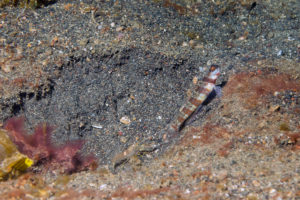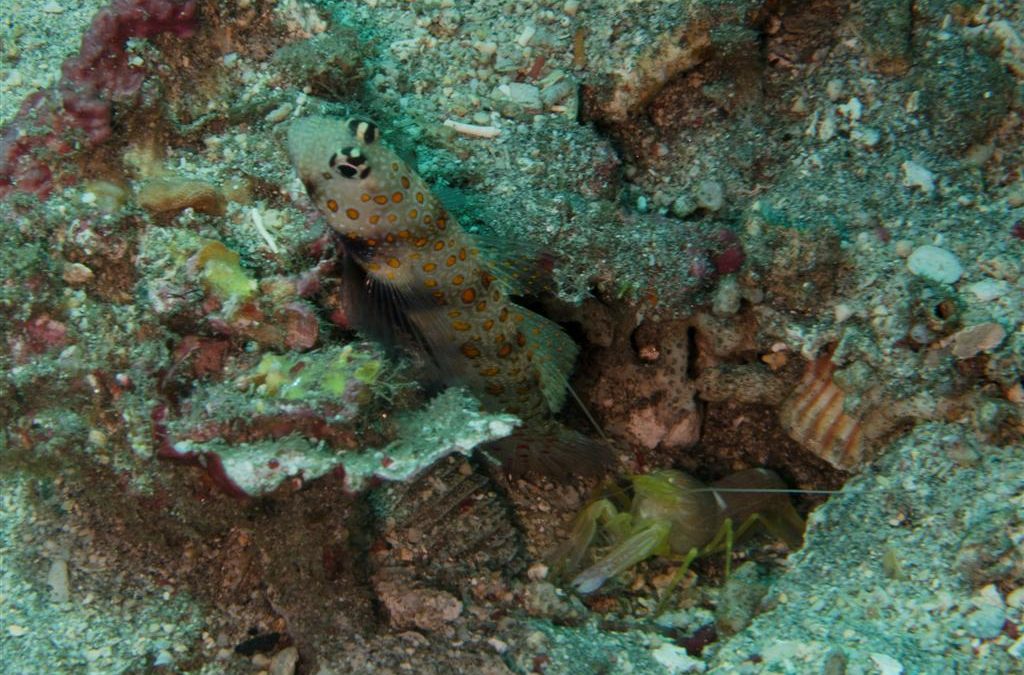Who would have thought that the symbiotic relationship between Goby Fish and Pistol Shrimp could be a surprisingly useful point of reference when discussing smart alliances?
Not me – until that is, I actually looked at these two small marine critters and noticed some definite lessons nature was teaching.
According to Johannes Duerbaum, writer for the Aquarium Fish International Magazine (as reported on FishChannel.com), “The shrimp builds and maintains a burrow that both animals live in, and the fish offers the shrimp protection from predators. When they are outside of the burrow, the fish keeps an eye out for predators and warns the Goby with a flick of the tail if a predator is nearby.” Evidently, once warned, the mostly blind shrimp dashes into the burrow thus being spared the prospect of a dinner-time cocktail cliché.
 Let’s review what each offers the other. The Pistol Shrimp digs the burrow (using its claws to push the sand like a tiny toy bulldozer), transporting all excavated material to the outside. This construction project can only occur if the Goby is on the outside standing guard ready to motion to its partner if there is any danger. At the first sign of any disturbance, the Goby signals to the shrimp’s antenna in a unique fashion. According to Duerbaum “The Goby’s dorsal or tail fin moves up and down or left to right in different frequencies, allowing the shrimp to withdraw, should danger approach.”
Let’s review what each offers the other. The Pistol Shrimp digs the burrow (using its claws to push the sand like a tiny toy bulldozer), transporting all excavated material to the outside. This construction project can only occur if the Goby is on the outside standing guard ready to motion to its partner if there is any danger. At the first sign of any disturbance, the Goby signals to the shrimp’s antenna in a unique fashion. According to Duerbaum “The Goby’s dorsal or tail fin moves up and down or left to right in different frequencies, allowing the shrimp to withdraw, should danger approach.”
The unlikely partnership occurs inside of the burrow as well as outside. Due to excavation action, the tunnel often collapses trapping the Goby under sand. And yet, the fish doesn’t panic. The shrimp (through smell) comes to the rescue and simply digs out its partner.
In other fascinating studies, the Goby has been observed as collecting algae and transporting it to the entrance of the burrow to its waiting partner. In repeated experiments, the fish could be seen actively feeding the shrimp.
Unusual work partners? Absolutely! But, that’s all they are. Neither the shrimp nor the fish makes any qualms about protecting their offspring from the other and, in fact, will go to great lengths to protect their eggs.
What is nature teaching us and what can we do differently in our workplaces as a result of studying the symbiotic relationship between the Goby Fish and the Pistol Shrimp?
#1 Look for a strategic alliance based on mutual benefit that satisfies an important need in both parties. You don’t have to be of the same discipline or industry (species) for a symbiotic relationship to work. What is your weakest area? What about your key strength? If you’re good at one thing (like burrow construction), but lack another skill set (like signaling danger or collecting algae), then identify which companies might be partnered with to help fill the gap. Alliances only work well when each brings perceived value to the other.
#2 Clear communication. Just like the Goby Fish signaling to the Pistol Shrimp – there should be zero ambiguity in messaging. Establish clear rules and approaches for communicating with one another.
#3 Pick a partnership based on compatibility as well as size. The Pistol Shrimp doesn’t choose a Goby Fish that’s too large to fit into a burrow, for the same reason the Goby won’t pair up with a shrimp if it’s too much of a shrimp. Keep in mind that size does matter among alliance partners, otherwise the lack of inequity can lead to quick derailment or, at the very least, one feeling subservient to the other.
#4 Pick alliances based on the ability to do more than satisfy one gap area. The Goby does more than signal danger to the shrimp – it also collects food. Likewise, the Pistol Shrimp can construct a burrow and rescue the Goby if trapped under tunnel sand. Stronger work alliances come from interaction on a couple of key fronts, but more importantly, from taking advantage of (in the best possible sense of the term) the many strengths of each partner.
#5 Respect each other’s agenda (food and burrow), but don’t get married. The Goby partners with the shrimp for what it can do for him and the Pistol Shrimp knows it, just like he constructs a burrow to share with the fish. There’s mutual benefit in the work arrangement. But to be clear, neither marries the other and has each other’s babies.
#6 An alliance is not a marriage. At best, it’s a work project. In fact, when intellectual property (offspring) is hatched, be careful to protect it. The shrimp doesn’t let the Goby near its eggs (IP) and vice versa. Strategic partnerships can work well, but only when clarity of roles and responsibilities is established and when ownership of any resulting IP has been earmarked.
For more information on this blog, contact me at info@zbglobal.com and don’t forget to check out my friends and colleagues at the San Diego Zoo Global BioInspiration Centre – they’re the experts when it comes to learning from nature.
